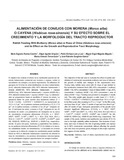| dc.rights.license | http://creativecommons.org/licenses/by-nc-sa/3.0/ve/ | |
| dc.contributor.author | Ramos Canché, María Eugenia | |
| dc.contributor.author | Aguilar Urquizo, Edgar | |
| dc.contributor.author | Lara y Lara, Pedro Enrique | |
| dc.contributor.author | Magaña Magaña, Miguel Ángel | |
| dc.contributor.author | Torres León, Marco Antonio | |
| dc.contributor.author | Sanginés García, José R. | |
| dc.date.accessioned | 2012-01-13T09:53:56Z | |
| dc.date.available | 2012-01-13T09:53:56Z | |
| dc.date.issued | 2012-01-13T09:53:56Z | |
| dc.identifier.issn | 0798-2259 | es_VE |
| dc.identifier.uri | http://www.saber.ula.ve/handle/123456789/34373 | |
| dc.description.abstract | El objetivo fue evaluar el efecto de la sustitución parcial del alimento
balanceado comercial por morera o cayena, sobre el
crecimiento de conejos y su tracto reproductor. Se utilizaron 20
gazapos de 35 días de edad distribuidos en cinco tratamientos
(n=4): alimento balanceado (AB); 60% alimento balanceado +
morera (60AB+M); 60% alimento balanceado + cayena
(60AB+Cay); 40% alimento balanceado + morera (40AB+M) y
40% alimento balanceado + cayena (40AB+ Cay). La alimentación
se proporcionó hasta el sacrificio (7 meses de edad). La
ganancia diaria de peso mostró una tendencia cúbica (Y =
19,35 + 0,438x - 0,00787x2 + 0,000027x3), se incrementó de
18,3 ± 4,3 gd–1 en la primera semana postdestete a 27,2 ± 7,9
gd–1 en la quinta semana, e inferior a los 20 gd–1 después de
las 13 semanas de edad, y menor a 8 gd–1 después de las 20
semanas de edad. Los parámetros de Gompertz de la curva
de crecimiento mostraron diferencias (P<0,05), a = 3633a;
2893b; 3258ab; 3148ab y 2887b; Xc = 65,2; 55,6; 64,6; 60,4 y
59,6; k = 0,0217bc; 0,0304a; 0,0175c; 0,0259ab y 0,0284ab, para
AB, 60AB+M, 60AB+Cay, 40AB+M y 40AB+Cay, respectivamente.
El peso del pene, testículos y epidídimos fue similar y
no se pudieron detectar diferencias (P>0,10) debido a la elevada
variabilidad dentro de tratamientos. La inclusión de morera
y cayena en la dieta de conejos en crecimiento puede sustituir
hasta un 60% el alimento balanceado comercial sin afectar la
tasa de crecimiento y no produce alteraciones macroscópicas
en los principales órganos reproductores de conejos machos. | es_VE |
| dc.language.iso | es | es_VE |
| dc.rights | info:eu-repo/semantics/openAccess | |
| dc.subject | Morera | es_VE |
| dc.subject | Cayena | es_VE |
| dc.subject | Tracto reproductor | es_VE |
| dc.subject | Tasa de crecimiento | es_VE |
| dc.title | Alimentación de conejos con morera (morus alba) o cayena (hisbicus rosa-sinensis) y su efecto sobre el crecimiento y la morfología del tracto reproductor | es_VE |
| dc.title.alternative | Rabbit feeding with mulberry (morus alba) or rose of china (hisbicus rosa-sinensis) and its effect on the growth and reproductive tract morphology | es_VE |
| dc.type | info:eu-repo/semantics/article | |
| dc.description.abstract1 | The objective of this trial was to evaluate the effect of partial substitution
of commercial concentrate mulberry and rose of china on
the growth of rabbits and changes in the reproductive tract.
Twenty baby rabbits were used with 35 days of age allotted to
five treatments: balanced food (AB), 60% concentrate + mulberry
(60AB + M), 60% concentrate + rose of china (60AB + Cay), 40%
concentrate + mulberry (40AB + M), 40% concentrate + rose of
china (40AB + Cay). Feeding was provided to slaughter (7 month
old). The daily weight gain showed a cubic trend (Y = 19.35 +
0.438x – 0.00787x2 + 0.000027x3), increased from 18.3 ± 4.3 gd–1
in the first week after weaning to 27.2 ± 7.9 gd–1 in the fifth week,
and less than 20 gd–1 after 13 weeks of age and less than 8 gd–1
after 20 weeks of age. Gompertz parameters of the growth curve
showed significant differences (P<0.05), a = 3633a, 2893b,
3258ab, 3148ab and 2887b; Xc = 65.2, 55.6, 64.6, 60.4 and 59.6, k
= 0.0217bc, 0.0304a, 0.0175c, 0.0259ab and 0.0284ab, for AB,
60AB+M, 60AB+Cay, 40AB+M and 40AB+Cay, respectively. The
weight of the penis, testicles and epididymis was similar (P>0.10)
due to the high variability within treatments. The inclusion of mulberry
and rose of china in the diet of growing rabbits can replace
up to 60% commercial concentrate without affecting the growth
rate and does not produce gross changes in the major reproductive
organs of male rabbits. | es_VE |
| dc.description.colacion | 509 - 516 | es_VE |
| dc.description.email | roberto.sangines@itconkal.edu.mx | es_VE |
| dc.description.frecuencia | Bimestral | es_VE |
| dc.identifier.depositolegal | 199102ZU46 | es_VE |
| dc.subject.institucion | Universidad del Zulia (LUZ) | es_VE |
| dc.subject.institucion | Universidad de Los Andes (ULA) | es_VE |
| dc.subject.keywords | Mulberry | es_VE |
| dc.subject.keywords | Growth rate | es_VE |
| dc.subject.publicacionelectronica | Revista Científica | es_VE |
| dc.subject.seccion | Revista Científica: Producción Animal | es_VE |
| dc.subject.thematiccategory | Medio Ambiente | es_VE |
| dc.subject.tipo | Revistas | es_VE |
| dc.type.media | Texto | es_VE |


